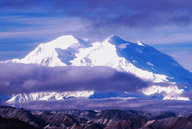North America's tallest mountain getting crowded
North America's tallest mountain is getting crowded too crowded for safety.

For the first time, the number of climbers allowed on the 20,320-foot (6096-meter) Mount McKinley in Alaska will be capped at 1,500 a year beginning in 2007 not too many more than the record 1,340 alpinists who attempted to scale the mountain last year.
McKinley, known locally as Denali or "the High One," is required climbing for many of the world's most serious mountaineers, who attempt to reach the summit of the highest peak on each of the seven continents. About half the climbers who attempt McKinley come from other countries, according to the National Park Service.
It's too late to restrict this year's climbing crowd.
"Whatever shows up this year, we will have to deal with. We are not prepared to turn back anybody this year," park ranger Daryl Miller said Friday.
The goal is safety and protecting the mountain, said Kris Fister, spokeswoman for Denali National Park and Preserve. She said all but a handful of climbers are on the mountain during a brief two-month period in May and June, and about 95 percent choose the West Buttress route to reach the top.
"You've got a lot of people homing in on one area of the mountain for a short period of time," Fister said.
Since 1903, McKinley has been attempted by 30,049 climbers and just over half have reached the summit. Ninety-five climbers have died trying, including a record 11 in 1992. Two brothers from Ohio died last year.
"It is amazing how the mountain just has gotten busier," Miller said.
The mountain also is popular because it's easy to get to compared to some others in the world _ just a two-hour car ride from Anchorage and a 45-minute flight from Talkeetna to base camp at 7,200 feet (2160 meters).
Climbers typically spend 14 to 18 days on the mountain, Miller said.
The large number of climbers spending so much time on Denali creates another big problem: human waste.
"There is just a certain amount you can deal with," Miller said.
Normally, you would never see the pit toilet, dug 14 feet (4.2 meters) deep into the Kahiltna Glacier at the base camp, because it is "devoured by the glacier," Miller said.
That wasn't the case last year. For the first time, the pit toilet was visible in an August flyover of the glacier, Miller said.
"It melted away all the way down to 14 feet where we dug and it was sitting on top of the ice," he said. "Now, we are concerned we may have to haul human waste off at 7,200 feet."
Climbers are required to carry and use small toilet containers above 17,200 feet (5160 meters), he said, reports AP.
O.Ch.
Subscribe to Pravda.Ru Telegram channel, Facebook, RSS!




